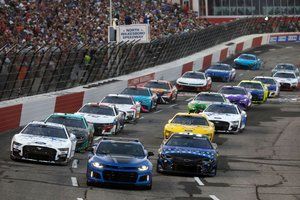Inside the intricacies of IndyCar set-up for the Brickyard
Chip Ganassi Racing has been the team to beat at the Indianapolis 500 during recent years. The squad’s performance director reveals his approach for the Speedway

Photo by: Michael L. Levitt / Motorsport Images
When you start with a new car, or with a new specification – like the manufacturer aerokits in 2015 or when we went back to a universal aerokit in 2018 – your focus is on driver comfort initially, and then you determine which are the areas for improving performance.
Obviously we’ve had this car for a while so, unloading at the Speedway, we already have a good idea of where to start in terms of set-up, where we might find extra pace, and also how to dial each car into a driver’s particular preferences. Last year at Indy, there wasn’t a ton of variance across our six cars, but there’s always three or four things that Scott Dixon likes different from Marcus Ericsson, and that Marcus likes different from Alex Palou.
And things change every year. We can’t go back to Indy with the same set-ups we ran last May. There have been aero changes to the cars via the regulations for 2023, ways to unlock more downforce – possibly more for race set-up than qualifying.
Wind and weather changes are notorious for having a big effect at Indy. Partly that’s because you have so much practice time compared with other races, you can get your car closer to the edge, and partly it’s because small changes make such a massive difference at those speeds. It’s important to use practice time to figure out all the details for making minor changes according to track conditions and still keep the car in the window in terms of handling and speed.
With the new pieces IndyCar has allowed us this year, based on the aero testing that we’ve seen, we think we have a pretty good idea how we want to run the car and where we think maximum performance will be, but on-track results can always be a little different from wind tunnel data. So as a team, we will divide the tasks among our four entries – one works on variables in this area, another works on variables in another area – and then we will debrief together at the end of first practice, revisit the things we’ve discovered, and move forward in what we hope will be a productive way the next day.

Whatever the conditions, car set-up is key to a successful Indy 500, and often dictates over a driver's preferences
Photo by: Phillip Abbott / Motorsport Images
The thing is, we can’t stay still. Even without the new aero pieces, we would have worked just as hard as this off-season on Indy set-ups because any advantage you have doesn’t last long. So getting all the areas covered in practice by four really experienced drivers – three of them Indy 500 winners already – is hugely important.
Come qualifying, the order in which each entry makes its first run is decided by draw on Friday evening. So we could have one of our drivers running first in line, and one of them making his run 34th: that means their runs could be two and a half or three hours apart, so what worked for the first guy is nothing like what might work for the last guy. We have predictive data for ambient and track temperatures, and it’s that, rather than driver preferences, that will cause the biggest differences in set-ups for those first runs.
For race set-ups, you are always looking ahead to the last couple of stints, what the track temp is going to be, predicting how the balance of the car is going to change, and keep ahead of that
Then once all 34 cars have got their first runs out of the way, if you want to make further runs – and you usually do, especially if your first run was a bit conservative – you get the chance to adjust for track conditions with each.
For race set-ups, you are always looking ahead to the last couple of stints, what the track temp is going to be, predicting how the balance of the car is going to change, and keep ahead of that. Sometimes that can mean you run a set-up that makes the car a bit of a handful in the first stint but will get better as more rubber goes down. Other times, if the predicted track temperatures are high from the beginning of the race, you might start with more downforce, then if grip levels come up later, you may be able to trim out for the final stints and hopefully push for the win.

Can Chip Ganassi Racing deliver another Indy 500 winner?
Photo by: Jake Galstad / Motorsport Images
Be part of Motorsport community
Join the conversationShare Or Save This Story
Subscribe and access Motorsport.com with your ad-blocker.
From Formula 1 to MotoGP we report straight from the paddock because we love our sport, just like you. In order to keep delivering our expert journalism, our website uses advertising. Still, we want to give you the opportunity to enjoy an ad-free and tracker-free website and to continue using your adblocker.















Top Comments